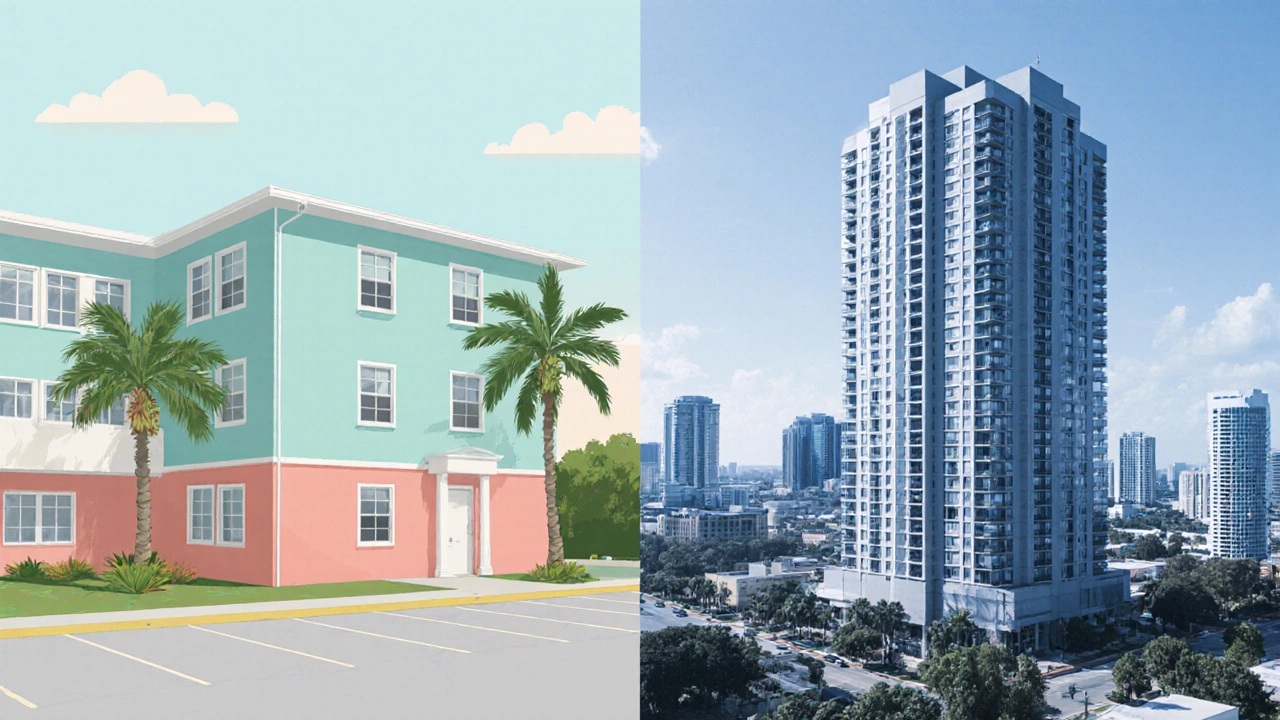Kissimmee Rent Affordability Calculator
Calculate if your income makes rent affordable in Kissimmee based on 2025 median prices. The 30% rule suggests housing should not exceed 30% of your gross income.
Key Takeaways
- In Q32025 the median rent for a one‑bedroom apartment in Kissimmee is $1,420, about 12% higher than the national median.
- Rent in Kissimmee is roughly 5% lower than neighboring Orlando but still above the Florida average.
- Tourism‑driven demand, limited new inventory, and a tight job market keep prices up.
- Households earning the median $62,300 annual income spend about 28% of their earnings on rent, just above the 30% affordability threshold.
- Look for units near the University of Central Florida campus or the Lake Buena Vista area for better value, and consider signing in the off‑season (September-November).
When people ask, Kissimmee is a city in central Florida, just south of Orlando and a short drive from Walt Disney World, the rental market usually tops the conversation. The question “Is the rent expensive in Kissimmee, Florida?” boils down to three jobs: (1) finding current rent figures, (2) comparing those numbers to nearby markets, and (3) deciding if the cost fits a personal budget.
Current Rental Prices in 2025
According to data from Zillow a real‑estate analytics platform that tracks rental listings nationwide, the median asking rent for a one‑bedroom apartment in Kissimmee is $1,420 per month, while a two‑bedroom fetches $1,750. Detached single‑family homes average $2,180 for three bedrooms and $2,700 for four bedrooms. These figures reflect listings posted between July and September 2025 and include both newly built complexes and older garden‑style units.

How Kissimmee Stacks Up Against Neighbors
| Location | Median Rent | Annual % Change (2021‑2025) |
|---|---|---|
| Kissimmee, FL | $1,420 | +14% |
| Orlando, FL | $1,500 | +12% |
| Tampa, FL | $1,360 | +10% |
| National Avg. | $1,270 | +9% |
| Florida Avg. | $1,350 | +11% |
Even though Kissimmee is slightly cheaper than Orlando, it still exceeds the state and national averages. The gap narrows when you compare to Tampa, where a one‑bedroom costs about $140 less. For families, the price difference widens; a three‑bedroom home in Orlando averages $2,300 versus $2,180 in Kissimmee, a modest saving that can add up over a lease term.
What Drives Rent Prices Here?
Three main forces push rent upward:
- Tourism and Disney proximity - Kissimmee’s close ties to Walt Disney World and other theme parks create a steady stream of seasonal workers and short‑term renters, swelling demand for year‑round housing.
- Limited new supply - Permitting delays and rising construction costs have slowed the rollout of new apartments. Between 2021 and 2025, only 1,200 new units were completed, far below the 2,500‑unit shortfall projected by the U.S. Department of Housing and Urban Development (HUD).
- Job market dynamics - The median household income in Kissimmee rose to $62,300 in 2025 (a 6% increase over 2021). While wages are climbing, they lag behind rent growth, squeezing affordability.
Rent Trends Over the Last Five Years
Historical data from the Cost of Living Index a composite metric tracking housing, transportation, and groceries shows a steady upward trajectory. From 2020 to 2025, the index for Kissimmee rose from 95.3 to 108.7 (a 14% increase), mirroring rent hikes of 12‑15% across the board. The biggest jump occurred in 2022‑2023, when post‑pandemic travel surged and developers struggled to keep up with demand.

Affordability Snapshot
The classic rule of thumb is to spend no more than 30% of gross income on housing. Using the 2025 median income ($62,300), a household can comfortably afford $1,558 per month in rent. The median one‑bedroom price ($1,420) sits just under that line, meaning about 57% of renters are within the “affordable” range, while the remaining 43% either share housing, live with roommates, or stretch beyond the guideline.
For families, the picture tightens. A four‑bedroom home at $2,700 represents 52% of the median household income-well above the 30% rule-so many families opt for two‑bedroom units and supplement space with basements or accessory dwelling units (ADUs).
Practical Tips for Rent‑Seekers
- Target off‑season months. Lease negotiations are strongest between September and November, after the summer tourist peak subsides.
- Explore neighborhoods beyond the Disney corridor. Areas like Poinciana and the Lake Buena Vista region often have lower per‑square‑foot rates while still offering easy freeway access.
- Consider shared housing. Platforms such as Roomster a roommate‑matching service list rooms in larger homes for $800‑$950, dramatically cutting costs.
- Ask about rent‑to‑own programs. Some local developers partner with the Florida Housing Finance Corporation to offer lease‑to‑own options, allowing tenants to build equity over a 5‑year term.
- Leverage credit. A solid credit score can shave $50‑$100 off monthly rent, as landlords reward low‑risk tenants.
Finally, keep an eye on the Consumer Price Index (CPI) the federal measure of inflation. When CPI rises, landlords often adjust rents in July and December, so budgeting for a potential 2‑3% bump can prevent surprise expenses.
Frequently Asked Questions
What is the average rent for a one‑bedroom apartment in Kissimmee?
As of Q32025, the median rent for a one‑bedroom unit is about $1,420 per month, according to Zillow’s market analysis.
How does Kissimmee rent compare to Orlando?
Kissimmee’s median one‑bedroom rent is roughly 5% lower than Orlando’s $1,500 average, but the difference narrows for larger homes.
Is rent in Kissimmee considered affordable?
For a single‑person household, the median rent stays just under the 30% income‑to‑rent guideline, making it marginally affordable. Families often need to share units or look outside the city center to stay within that threshold.
What neighborhoods offer the best rent‑to‑value ratio?
Poinciana, the Lake Buena Vista area, and the northern edge of the city near the University of Central Florida campus typically list lower rents while still providing easy highway access.
Will rent increase this year?
Given the 2025 CPI rise of 3.2% and a continued shortage of new units, a modest 2‑3% increase in July and December is likely.


Patrick Tiernan
October 10, 2025 AT 17:00Yo the rent in Kissimmee is just another overpriced nightmare for the clueless
Patrick Bass
October 11, 2025 AT 19:26The calculator seems functional.
Colby Havard
October 12, 2025 AT 23:13One must consider, with utmost seriousness, the ethical implications of fostering a housing market that systematically inflates beyond the reasonable means of the average citizen; moreover, the moral responsibility of policymakers cannot be ignored, for they hold the power to enact regulations that protect vulnerable families; consequently, it is incumbent upon us to demand transparent pricing and equitable access to safe dwellings.
Amy P
October 14, 2025 AT 03:00Imagine stepping onto a sun‑drenched balcony, the scent of orange blossoms drifting through the air, only to realize the lease you just signed will swallow a third of your paycheck; the narrative of affordability becomes a dramatic saga when families juggle dreams of Florida sunshine against the relentless tide of rising rent, and the calculator you posted shines a harsh spotlight on that tension.
Ashley Kuehnel
October 14, 2025 AT 16:53Hey folks, just wanted to hop in and break down the numbers a bit more so everyone can see the full picture.
First, the median rent for a 1‑bedroom in Kissimmee for 2025 is hovering around $1,350 per month.
Using the 30% rule, that means you’d need an annual income of about $54,000 to comfortably afford it.
If you’re earning less than that, you might want to consider a roommate situation or a smaller unit to keep housing costs within a safe budget.
For a 2‑bedroom, the median jumps to roughly $1,750, which translates to needing about $70,000 yearly.
That’s a steep climb for many families, especially those with kids or other financial obligations.
It’s also worth noting that utilities and transportation costs in the area can add another $200‑$300 to your monthly expenses.
So when you calculate your total cost of living, don’t forget to factor those in.
If your income is variable, such as gig work or seasonal employment, aim for a higher cushion-perhaps 35% of your income instead of 30%-to avoid getting squeezed during slower months.
Many locals find that moving a few miles out of the tourist hotspots can shave $100‑$200 off rent while still keeping you within a reasonable commute distance.
Also, keep an eye on community programs that offer rental assistance or subsidized housing; they can make a big difference.
In short, the calculator is a great starting point, but the real magic is in digging deeper into your personal budget and local resources.
Hope this helps, and feel free to ask if you need more specific advice about budgeting or finding deals.
Good luck navigating the Kissimmee market!
adam smith
October 15, 2025 AT 06:46The numbers look high but the data seems accurate.
Mongezi Mkhwanazi
October 16, 2025 AT 10:33When one examines the broader socioeconomic landscape of central Florida, it becomes evident that the escalation in rent prices is not an isolated anomaly, but rather a manifestation of systemic forces, including population influx, limited housing stock, and speculative investment practices, which collectively exert upward pressure on market rates; furthermore, the disparity between wage growth and housing costs has widened to a point where many households are compelled to allocate disproportionate portions of their income to secure shelter, thereby compromising their capacity to invest in education, healthcare, and retirement savings; consequently, policymakers must engage in comprehensive urban planning, incentivize affordable housing development, and implement rent stabilization measures, lest the region witnesses an exacerbation of economic inequality and a potential exodus of essential workers; in this context, the calculator serves as a valuable diagnostic instrument, highlighting the extent to which individual earnings intersect with macro‑economic trends, and it underscores the urgency for collaborative solutions that balance market dynamics with social welfare considerations.
Mark Nitka
October 17, 2025 AT 14:20Let’s keep the discussion constructive and focus on practical steps that can help both renters and landlords find common ground.